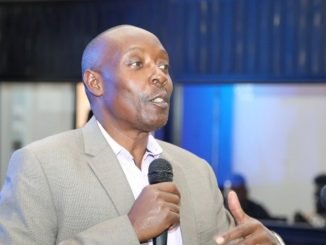
Kampala, Uganda | URN | The power distribution company, Umeme Ltd, is hopeful that the electricity connection policy suspended earlier this month could be restored between June 2021 and June 2022, but this will depend on the success of the current efforts to get funding.
The free connection policy, launched in 2018 was aimed at connecting 300,000 customers per year, and when it was suspended, about 240,000 customers whose applications had already been processed were left stranded.
For six months since May when the government stopped releasing money for the connections, there were no connection activities going on by the distribution companies including Umeme.
By then, the government implementing agency, the Rural Electrification Agency was owing to the distribution companies more than USD 25 million (95 billion Shillings).
The policy initially targeted to increase access to electricity from below 30 to 60 per cent in 10 years. Umeme Managing Director Selestino Babungi says there are many efforts ongoing by the government to get funding, including from somatic sources and foreign development partners. He fears that these could be affected by the effects of the pandemic on the economies of the development partners too.
Meanwhile, over the year, Umeme completed the USD 83.3m (310 billion Shillings) planned expenditure despite the challenges, to ramp up capacity enhancement and network stabilization programme in rapidly growing regions across its footprint. The money is part of the USD 450m (about 1.7 trillion Shillings) for the 2019 and 2025 investment agenda.
The Umeme Managing Director said he is satisfied that the company has completed all the investment works that were laid out for 2020 on time. This comes as industrialists decry increased power outages which are impacting on their businesses.
Umeme attributes this to the rainy season that usually comes with storms, which damages electricity installations. A new system that will enhance the rapid response by the company to technical faults like transformer breakdowns, cables or poles and any other emergencies, is being installed by the company.
The geospatial network information system has been approved by the Electricity Regulatory Authority [ERA] for installation and its procurement will be concluded later in January.
The system will also integrate customer management with the payment systems, with a hope to respond to constant complaints about wrong billing and under-crediting of customers’ accounts after payment.
This will also be supported by another system that will include digitally mapping of all customer premises and electric installations. The system being developed by General Electric, a US-based company with operations in South Africa.
With this, Babungi says, they are introducing what they are calling “uberisation of emergency response” where a technical problem reported will be responded to by the nearest staff, instead of first calling the area office and then asking for directions.
“We started the year with 190,000 postpaid customers but am happy to note that we have converted 160,000 customers to prepaid. This helped to limit human interaction and also address losses as well as improve operational efficiency in customer service,” he explains.
Umeme hopes that the successful investments they have made in recent years, will encourage the government to renew its license that is due to run out in five years.
Babungi says the negotiations should continue after 2021 general elections, adding that the delays in concluding the negotiations are making it difficult for them to get new investment capital.
Meanwhile, there were mixed fortunes in the electricity supply business, with some consumer segments recording increased demand, while others saw demand fall during the year, mainly influenced the COVID-19 pandemic.
The MD says that while domestic and large industrial consumers saw demand rise, there was a fall in consumption by SMEs and their activities were impacted by the pandemic.
The major projects undertaken this year are the Siti project including Siti line, Tororo line, a switching station in the Mbale industrial park and upgrade of the Mbale substation which was all completed.
The company also upgraded other substations in Gulu, Ntinda, and built a new station in Nakawa, to improve on the capacity Kampala to address the growing power demand from housing developments and industrial areas in the Nakawa and Bugolobi areas.
Read Also: Uganda power distributor Umeme unveils Shs 800 billion plan for 2021
The Mukono North substation, commissioned by President Museveni today (Monday), is now in use after the construction of lines to link the facility with consumers.
Umeme has erected poles and strung cables from the facility in Mbalala, Mukono District to Katosi, 40 kilometres away, Mpata and within Mbalala.
It has also connected lines that will provide National Water and Sewerage Corporation’s Katosi water station, Tian Tang, and Kampala Cement factories, among other industrial consumers of power, with reliable and quality power.



